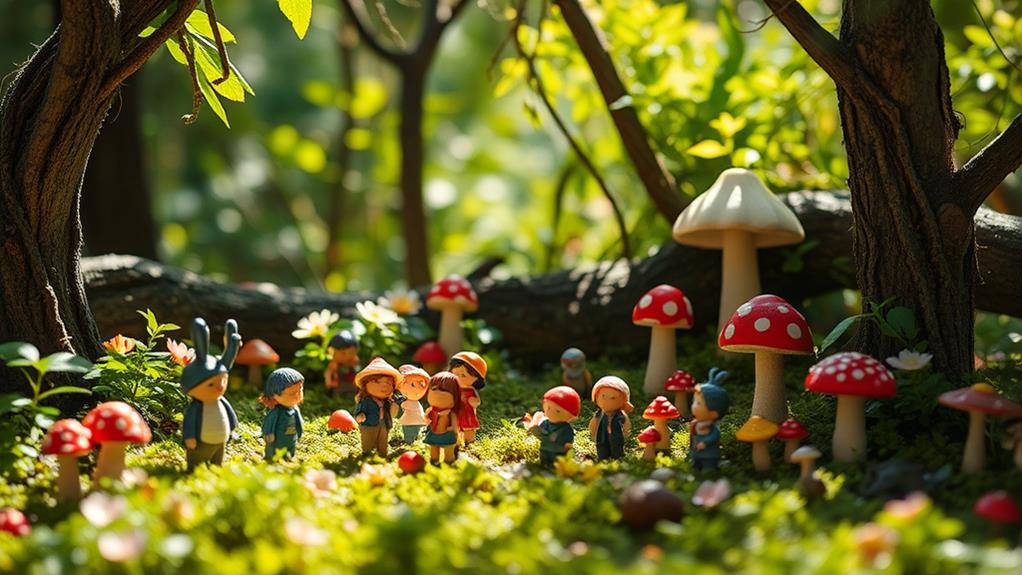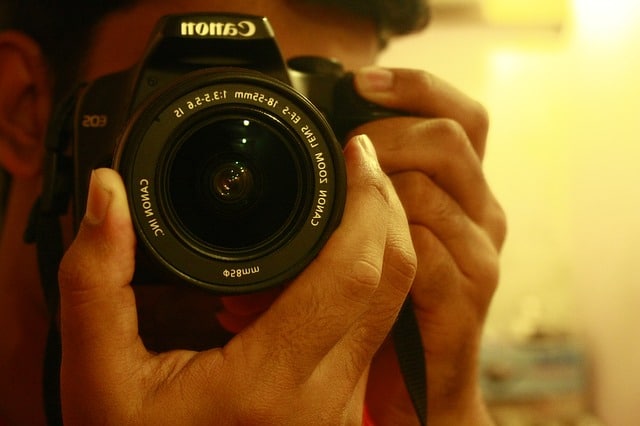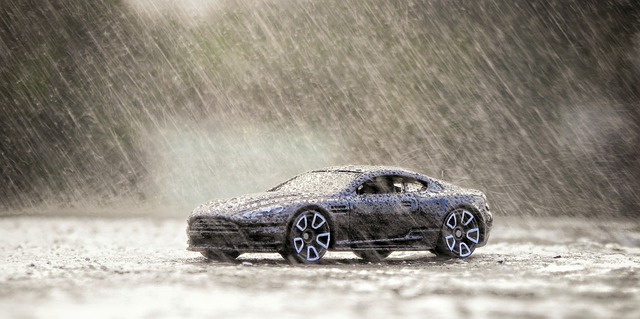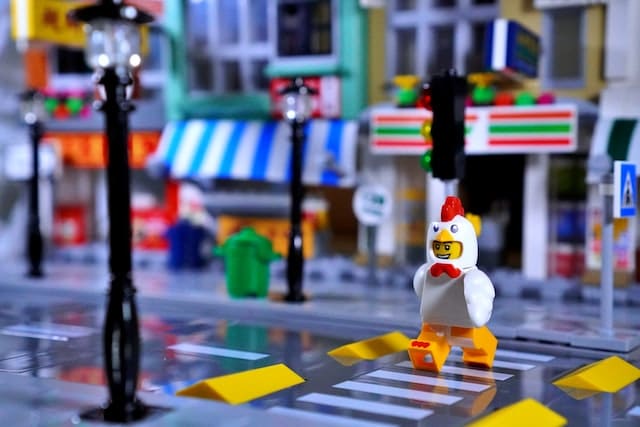Enhance your figurine photography by mastering creative composition techniques. Start with the Rule of Thirds to position your figurines attractively within the frame. Use leading lines, like table edges or natural shadows, to draw eyes directly to your subject. Framing techniques using elements like windows or tree branches can add unique borders around your figurines. Play with symmetry and balance to bring harmony and dramatic effect. Don't overlook negative space, which enhances focus and storytelling. Experiment with angles—from low to overhead—and choose backgrounds that enhance colors and mood. To discover further tricks and nuances, there's much more in store.
Rule of Thirds
One of the simplest and most effective techniques to enhance your figurine photography is the Rule of Thirds. Imagine your camera's frame divided into nine equal parts by two equally spaced horizontal lines and two equally spaced vertical lines. When you're capturing your figurines, position them along these lines or at their intersections. This method helps create a balanced composition that's naturally pleasing to the eye.
By placing your figurine off-center, you draw attention not just to the subject but also to the surrounding space. This technique adds depth and interest to your photos, making them more dynamic. You'll notice how the Rule of Thirds can transform a static image into something that feels more engaging and alive.
To apply this method, use your camera's grid feature if available. Position key elements of your figurine, like the eyes or hands, on the intersection points. You don't always have to follow the rule strictly, but it's a great starting point for achieving a professional look. Experiment with different figurine poses and angles to see what works best while keeping the Rule of Thirds in mind.
Leading Lines Usage
Incorporate leading lines to guide your viewer's eye directly to your figurine, enhancing the storytelling aspect of your photo. These lines can be anything from a road, a row of trees, or even the edge of a table. They create a visual path that naturally draws attention towards your subject. When you position your figurine at the point where these lines converge, you're giving viewers a clear destination, making your composition more engaging and dynamic.
To effectively use leading lines, first identify elements in your scene that can serve this purpose. Angles and directions matter, so experiment by changing your camera position or adjusting the figurine's placement. Get creative with both vertical and horizontal lines; each can evoke different emotions and narrative cues. For instance, a diagonal line might suggest movement, while a vertical line can convey strength.
Don't forget about natural elements like sunlight or shadows, which can also function as leading lines. These subtle cues can add depth and dimension to your shot. Use them to create a more immersive environment for your figurine. By thoughtfully incorporating leading lines, you'll craft photographs that captivate and direct attention seamlessly.
Depth of Field

When you're aiming to add a professional touch to your figurine photography, playing with depth of field can make a world of difference. Depth of field refers to the zone of your image that appears sharp. By controlling it, you can draw attention to the figurine and blur out distracting backgrounds, making your subject pop.
To start, adjust your camera's aperture settings. A wide aperture (a smaller f-number like f/2.8) creates a shallow depth of field, which is great for isolating your subject. This technique highlights the figurine's details while elegantly blurring the background. Conversely, a narrow aperture (a larger f-number like f/16) increases the depth of field, keeping more of the scene in focus. This might be useful if your composition involves multiple figurines or intricate backgrounds.
Consider your camera's focal length, too. Using a longer lens can naturally compress the depth of field, enhancing the bokeh effect. It's also essential to position your camera closer to your subject for that intimate feel, intensifying the depth of field adjustments. Experiment with these settings to discover unique perspectives and add compelling depth to your figurine photography.
Framing Techniques
For capturing enchanting figurine photos, mastering framing techniques is essential. You want your figurines to shine, so start by considering the rule of thirds. Divide your frame into nine equal sections using two horizontal and two vertical lines. Position your figurine along these lines or at their intersections to create a more balanced and engaging composition. This simple method draws the viewer's eye naturally toward the subject.
Next, experiment with leading lines. These are lines within the frame that guide the viewer's gaze to your figurine. They could be a pathway, a shadow, or even the edge of a shelf. Leading lines add depth and interest, making your photos more dynamic.
Don't forget about natural framing. Use elements like window frames, doorways, or tree branches to create a border around your figurine. This technique provides context and directs attention straight to your subject.
Also, try varying your angles. Shooting from different perspectives can dramatically change the story your photo tells. Look for unique angles that emphasize the figurine's features, and don't be afraid to get creative. By applying these framing techniques, you'll elevate your figurine photography to new heights.
Background Selection

How can the right background transform your figurine photography? It serves as more than just a backdrop; it becomes an integral part of the story you're telling. A well-chosen background can enhance your figurine's colors, emphasize its details, and even evoke the right mood or atmosphere. When selecting a background, think about the narrative you want to convey. Is your figurine a mythical creature? A lush forest or cloudy sky could amplify its fantasy elements.
Consider the colors in your figurine. Complementary backgrounds can make the figurine pop, while similar tones can create a more harmonious, subtle composition. For instance, a vibrant red cape on a figurine might stand out beautifully against a muted, earthy background.
Texture is another critical element. A smooth, plain background keeps the focus on your figurine, whereas a textured backdrop can add depth and interest. However, verify it doesn't overshadow your main subject.
Lastly, think about the background's relevance to the figurine's theme. A historical figure might look more authentic with a vintage map as a backdrop, while a modern superhero could benefit from an urban skyline. Choose wisely, and watch your photography transform.
Symmetry and Balance
Symmetry and balance are key in creating visually appealing figurine photographs. When you're setting up your shot, consider how these elements can enhance your composition. Symmetry often brings a sense of harmony and order, making your image pleasing to the eye. It's not just about mirroring; it can be about arranging elements so they feel equal and stable. Balance, on the other hand, involves distributing visual weight evenly, ensuring no part of your photograph feels neglected or overpowering.
To achieve this, think about:
- Central Placement: Position your figurine in the middle to create a symmetrical composition, drawing the viewer's focus directly to your subject.
- Background Elements: Use background features like trees or buildings to frame your figurine symmetrically, enhancing the sense of balance.
- Negative Space: Balance your figurine with empty spaces around it to prevent your photograph from feeling crowded or off-kilter.
Experiment With Angles

One of the secrets to enchanting figurine photography lies in experimenting with angles. You'll be amazed at how a simple shift in perspective can transform a mundane shot into a mesmerizing piece of art. When photographing figurines, don't just settle for the typical eye-level view. Instead, try capturing them from above, below, or even at a slant. Each angle tells a different story and highlights unique aspects of the figurine that might otherwise go unnoticed.
Start by getting down low to bring your viewer eye-to-eye with your subject. This angle can emphasize the figurine's stature and make it appear more lifelike. Alternatively, shooting from above can create a sense of vulnerability or highlight intricate details on the top surfaces that are often overlooked. Side angles can also add depth and reveal the three-dimensionality of your figurine.
Use of Negative Space
Angles can dramatically change the way your figurines are perceived, but the magic doesn't stop there. Using negative space effectively in your photos can elevate your composition, making the figurine stand out and communicate more powerfully. Negative space is the area surrounding your subject that isn't occupied by any other elements. It's not just empty space; it's a tool that can add balance and focus to your shots.
To harness the power of negative space, consider these tips:
- Create Breathing Room: Allow space around your figurine to help it stand out. This highlights the details and shapes without overwhelming the viewer.
- Enhance Storytelling: Use negative space to guide the viewer's eye, creating a narrative or emotional impact. It can suggest solitude, vastness, or even serenity.
- Add Depth: By balancing your figurine with surrounding space, you can enhance the three-dimensionality of your image, giving it a more lifelike feel.
Experiment with different backgrounds and compositions to see how negative space influences the mood and focus of your photos. The right amount of space can transform an ordinary snapshot into a striking visual statement.
Frequently Asked Questions
How Can Lighting Affect the Mood of a Figurine Photograph?
Lighting’s essential in setting a photograph’s mood. Use soft lighting for serene, gentle feelings or harsh lighting for drama and intensity. Experiment with angles and shadows to evoke different emotions, making your figurine scene truly enchanting. Additionally, the placement of your figurines can dramatically alter the narrative of your images. By strategically positioning them in relation to the light source, you can highlight certain features, thus enhancing the emotional impact of figurine photography. Remember, the interplay of light and shadow can create dynamic contrasts that draw viewers in and invite them to explore the story behind each piece.
What Props Can Enhance the Storytelling Aspect of Figurine Photography?
You can enhance storytelling in your figurine photography by using props like miniature furniture, natural elements, or themed backgrounds. These props create context, add depth, and make your figurines feel more alive and part of a narrative.
How Do I Choose the Right Color Scheme for My Figurine Photos?
Channel your inner Van Gogh when choosing colors; think about mood and harmony. Use complementary colors to make your figurines pop, or go monochrome for drama. Consider your scene's story and let it guide your palette decisions.
What Are Some Post-Processing Tips to Enhance Figurine Images?
Use post-processing to enhance clarity and colors. Adjust brightness and contrast for depth. Use sharpening tools for details and play with saturation to make colors pop. Don't overdo filters, as they can distract from the figurine.
How Can I Create a Dynamic Scene Using Multiple Figurines?
Arrange figurines in varied poses to tell a story. Use different levels and angles to add depth. Consider lighting for dramatic effects and use props to enhance the scene. Experiment with backgrounds for added context and interest.
At a Glance
In your hands, the tiny world of figurine photography transforms into an artful dance of light and shadow. By embracing the rule of thirds and leading lines, you guide the eye; with depth of field and framing, you sculpt the scene. Choose your backgrounds wisely, balance with symmetry, and don't shy away from experimenting with angles and negative space. Remember, every click of the shutter is a brushstroke on the canvas of imagination—your masterpiece awaits.





